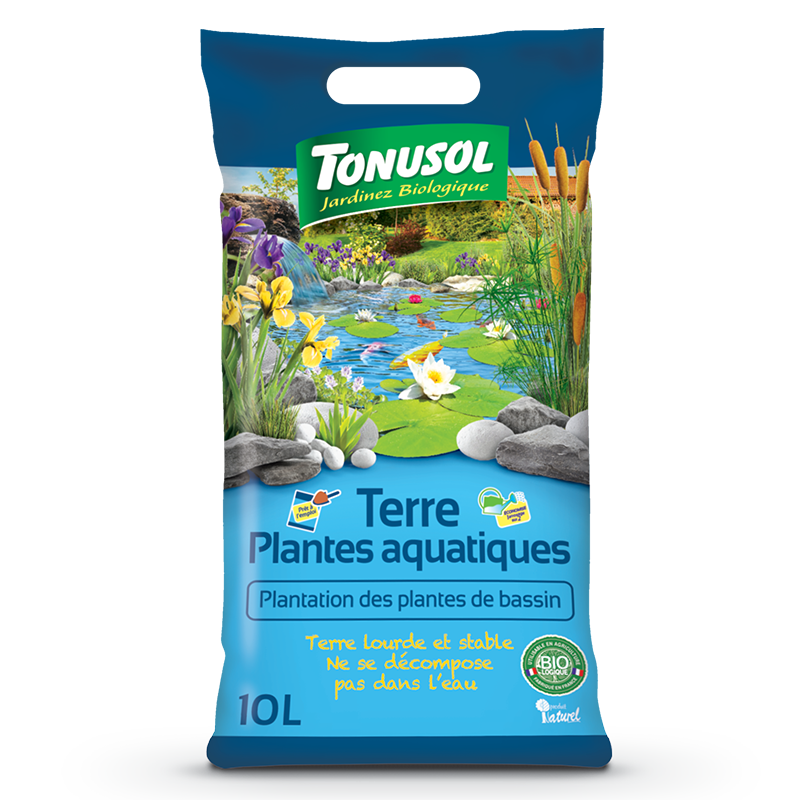Organic Aquatic Plants Soil
Tonusol’s Organic Aquatic Plants Soil has been designed specifically for planting and repotting all kinds of aquatic plants: water lilies, water irises, yellow flag irises, Japanese horsetails, tubular plants, aquatic grasses, flowering rushes, reeds...
The specific formula of this soil meets these plants’ requirements: they necessitate a wet milieu, preferring an environment near the water or in some cases partially submerged. Soak this soil in water beforehand so that it is compact and sticky before placing it in the pond.
Spécificités
Organic aquatic plant soil, the essential ally for a natural and healthy pond
Building a natural pond in your garden means creating a true haven of peace for biodiversity. Aquatic plants, with their bright colors and elegance, play an essential role in this ecosystem. To ensure their optimal growth and promote a healthy environment, the choice of substrate is essential. Let's find out why Tonusol Aquatic Plant Soil is the most suitable option for aquatic plants and how it contributes to a balanced pond.
Ready to use for planting in ponds, it is advisable to soak this soil in water beforehand so that it is compact and sticky before placing it in the pond.
NFU 44-551 growing medium / Heavy and stable soil.
PRODUCT BENEFITS
Ready to use for planting in ponds, growing plants in pots, tubs and planters. Product usable in organic farming in accordance with EC regulations 834/2007 and 889/2008.
- The very fibrous blond sphagnum peat helps to saturate the substrate and fixes the nutrients to allow better rooting
- The very heavy topsoil does not float in water
- The pozzolan prevents fish from digging up the plant by digging in the substrate, it is an excellent bacterial support
Why choose organic soil for your aquatic plants?
Respect for the environment: Organic soil is made from natural and composted raw materials, without the addition of chemical fertilizers or pesticides. It thus preserves the quality of the water and does not pollute the environment.
Natural nutrition: Rich in organic matter, organic soil provides aquatic plants with all the nutrients necessary for their development. The microorganisms present in the compost promote a slow and progressive degradation of organic matter, thus ensuring a continuous release of nutrients.
Improved soil structure: Organic soil improves the structure of the substrate, making it more aerated and draining. This facilitates the rooting of plants and promotes biological activity.
Lush aquatic plants: Tonusol organic soil provides plants with all the nutrients they need to grow quickly and harmoniously.
Stimulation of microbial life: Organic soil is teeming with beneficial microorganisms that contribute to the decomposition of organic matter, nitrogen fixation and protection of plants against diseases.
The Tonusol formula meets the requirements of these plants that require a humid environment, preferring the water's edge or liking to be completely submerged. Pre-soak the soil in water so that it is compact and sticky before placing it in the pond.
Organic soil is a key element for the success of a natural pond. By choosing a quality product, you promote the development of a balanced and aesthetic ecosystem, while respecting the environment.
Avantages produit




Conseils d'utilisation
Lieu d'utilisation

A l'intérieur

Balcon / Terrasse

Jardin

A l'intérieur

Balcon / Terrasse

Jardin
How to use Tonusol vegetable fertilized soil
- J
- F
- M
- A
- M
- J
- J
- A
- S
- O
- N
- D
White sphagnum peat moss, topsoil, pozzolan.
SMALL AQUATIC PLANTS (0 to 20 cm) (0 to 8 inches)
For small plants, prepare them as a root ball enclosed in planting bags made of burlap, openwork canvas, or natural coconut geotextile. Planting bags allow you to plant along the edge when creating a pond. They allow for good plant growth by conserving heat and moisture at the foot of the plant in order to limit watering.
- Remove the plant from its pot and untangle the roots of the root ball.
- Place the root ball in its container.
- Soak this soil in water beforehand so that it is already compact and sticky when placing it in the pond.
- Put some Tonusol’s Organic Aquatic Plants Soil and pack lightly.
- Place the planting bags in the desired location.
MEDIUM AQUATIC PLANTS (20 to 40 cm) (8 to 16 inches)
For medium plants, prepare them in pots, preferably ones designed for aquatic environments: jars or openwork plastic baskets that allow gas exchange between the soil in the pot and the water in the pond.
- Avoid putting several plants in the same pot: they are often vigorous and do not like competition.
- Soak the soil well in water to avoid dry particles rising to the surface.
- Make a hole in the dirt at the center of the pot to place the plant. Take the plant out of its container and untangle the roots well so that they develop all inside the pot.
- Position the pot in the pond at the recommended height for that particular plant.
- Add gravel or pebbles to the surface to keep the basket at the bottom.
TALL AQUATIC PLANTS (40 to 150 cm) (16 to 60 inches / 5 feet)
For tall plants, place them in the water in wooden or plastic baskets.
- Soak the soil well in water to prevent dry particles from rising to the surface.
- Make a hole in the dirt at the center of the pot to place the plant. Take the plant out of its container and untangle the roots well so that they develop all inside the pot.
- Add gravel or small pebbles to the surface of the basket to keep it at the bottom of the pond.
- Position the basket at the recommended height for that particular plant. Place the pot and wait for the leaves to rise to the surface.




